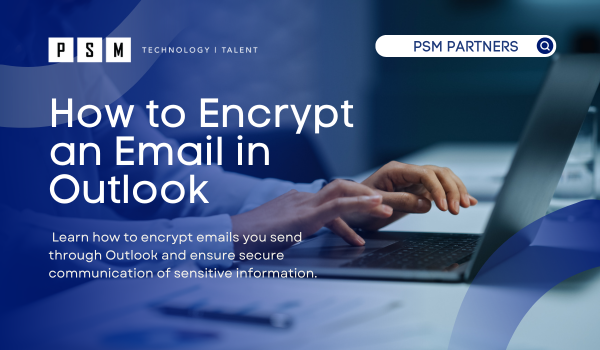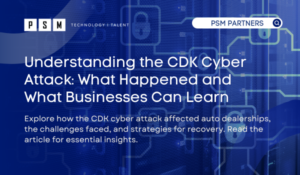Table of Contents
ToggleIn today’s fast-paced business world, protecting sensitive information has become a top priority for companies. One of the ways to ensure secure communication is by encrypting emails. Encrypting emails is a way of encoding messages to ensure that only authorized persons can access the content. In this blog post, we will explore how to encrypt email in Outlook, one of the most popular email clients used by businesses worldwide.
What is Email Encryption?
Email encryption disguises email content in a coded language, decipherable only by the sender and the receiver.
PKI, or “Public Key Infrastructure,” is one method to encrypt and decrypt emails, using a system that assigns each individual a digital key.
The public key is stored with the person’s name and email address on a key server, making it accessible to anyone who needs it.
The private key is stored securely on the individual’s computer, allowing only the original user to decrypt emails.
Why Encrypt Emails in Outlook?
Encrypting emails provides a layer of protection to sensitive information shared over the internet. This information can range from financial data to personal information. Encryption ensures that the content of the email is unreadable and useless to anyone who intercepts it. When you encrypt an email message, it undergoes a transformation from easily readable plain text to a jumbled cipher text. The deciphering of the message for reading is only possible by the intended recipient who possesses the private key corresponding to the public key used for encryption. Without the associated private key, any recipient will only encounter incomprehensible text.
In today’s world, where cyber threats are on the rise, encrypting emails can help prevent data breaches, identity theft, and other cyber-attacks. Additionally, some regulations, such as HIPAA and GDPR, require that sensitive information is protected by encryption during transmission.
Encryption Options in Microsoft Outlook
You have the option to customize the encryption settings in your Microsoft Outlook account, providing various levels of security:
Unrestricted: This is the default format for emails and does not include any additional security measures.
Encrypt Only: With this setting, the recipient is required to authenticate their identity using a one-time passcode before they can access and read the message.
Do Not Forward: In addition to the Encrypt Only feature, this setting prevents the recipient from forwarding the message to others.
Confidential / All Employees: This setting restricts access to approved recipients with authorized email accounts, which can be limited to specific staff members.
How to send an Encrypted Email in Outlook
Outlook offers various options for encrypting emails, depending on the version of Outlook and the email service provider. In this blog post, we will discuss how to encrypt email in Outlook using different methods.
Encrypt Individual Emails Using Microsoft 365 Message Encryption
Microsoft 365 Message Encryption is a powerful tool that allows users to encrypt emails in Outlook. This feature is available in Microsoft 365 Business, Enterprise, Education, and Government plans. You can encrypt individual emails in Outlook by following these steps:
Step 1: Compose a new email message in Outlook.
Step 2: Click on the “Options” tab in the ribbon at the top of the email window.
Step 3: Click on “Encrypt” in the “Permission” section of the ribbon.
Step 4: Select “Encrypt-Only” or “Do Not Forward” options from the drop-down menu. The “Encrypt-Only” option will encrypt the email, while the “Do Not Forward” option will prevent the recipient from forwarding or copying the email content. You can choose to encrypt the message only, or both the message and its attachments.
Step 5: After selecting your encryption options, click on the “Send” button to send the encrypted email.
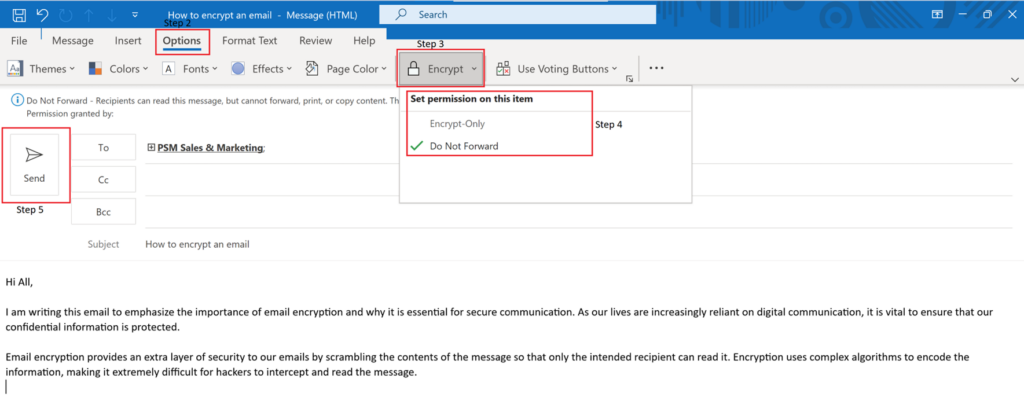
Encrypt All Outgoing Emails
If you want to encrypt all outgoing emails, you can set up Outlook to do so automatically. To do this, follow these steps:
Step 1: Open Outlook and click on the File tab.
Step 2: Click on the Options button and select “Trust Center.”
Step 3: Click on the “Trust Center Settings” button.
Step 4: In the Trust Center dialog box, click on the “Email Security” tab.
Step 5: Under the Encrypted email section, check the box next to “Encrypt contents and attachments for outgoing messages.”
Step 6: Click on the OK button to save your changes.
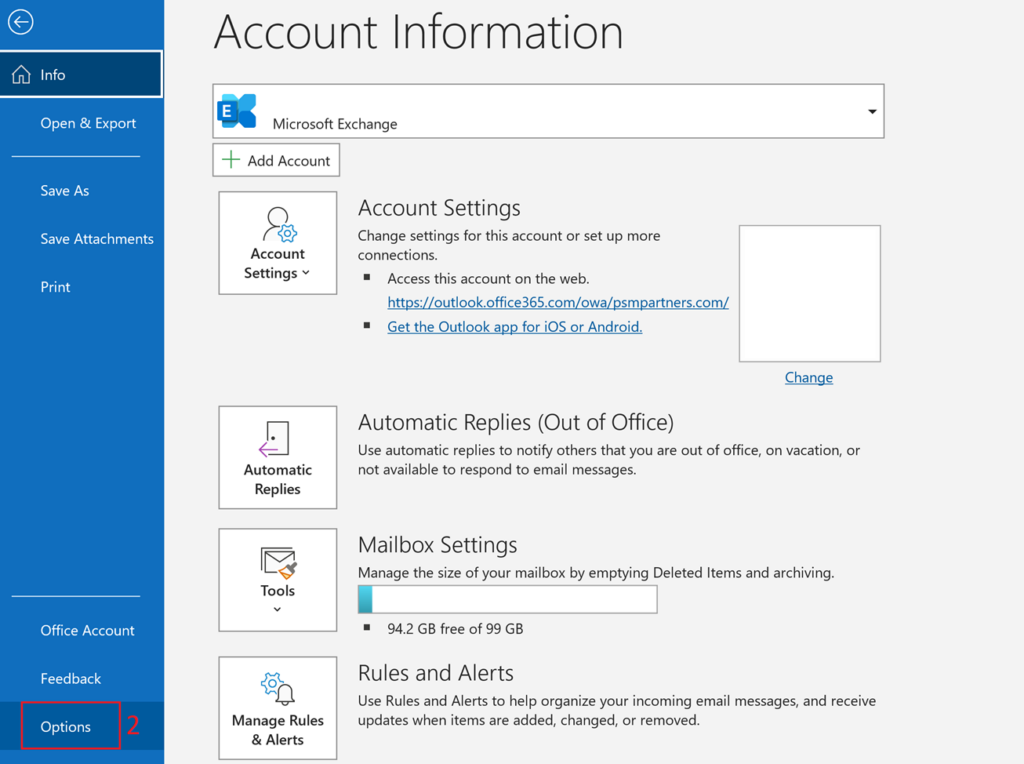
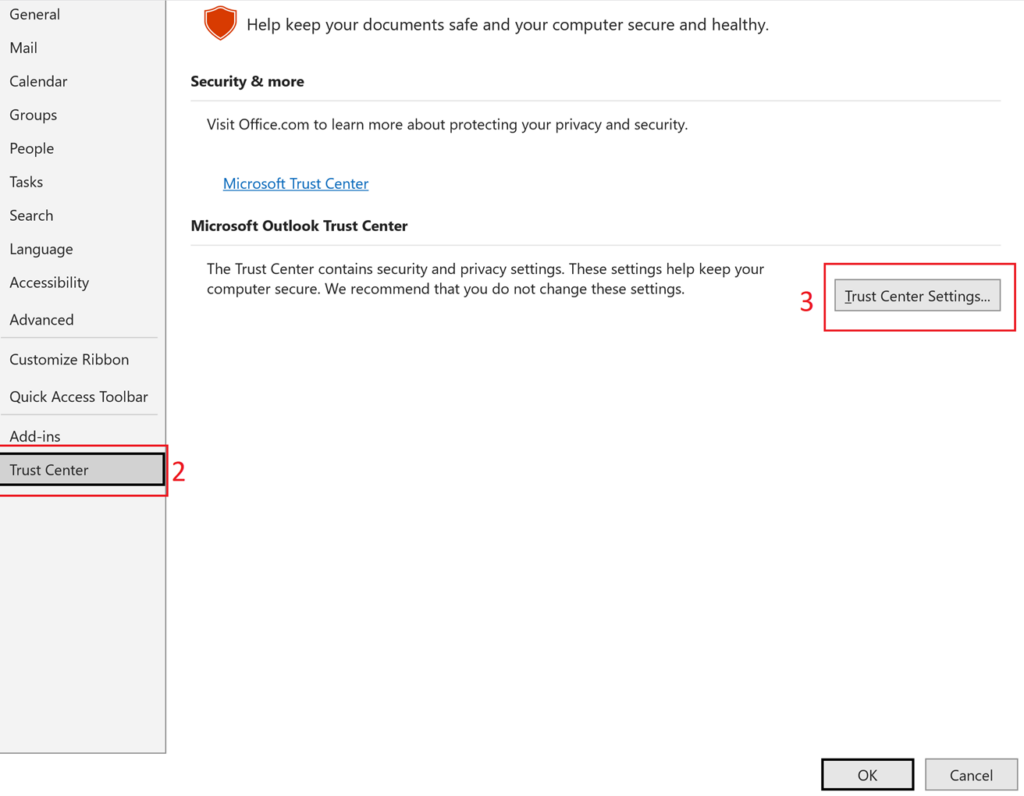
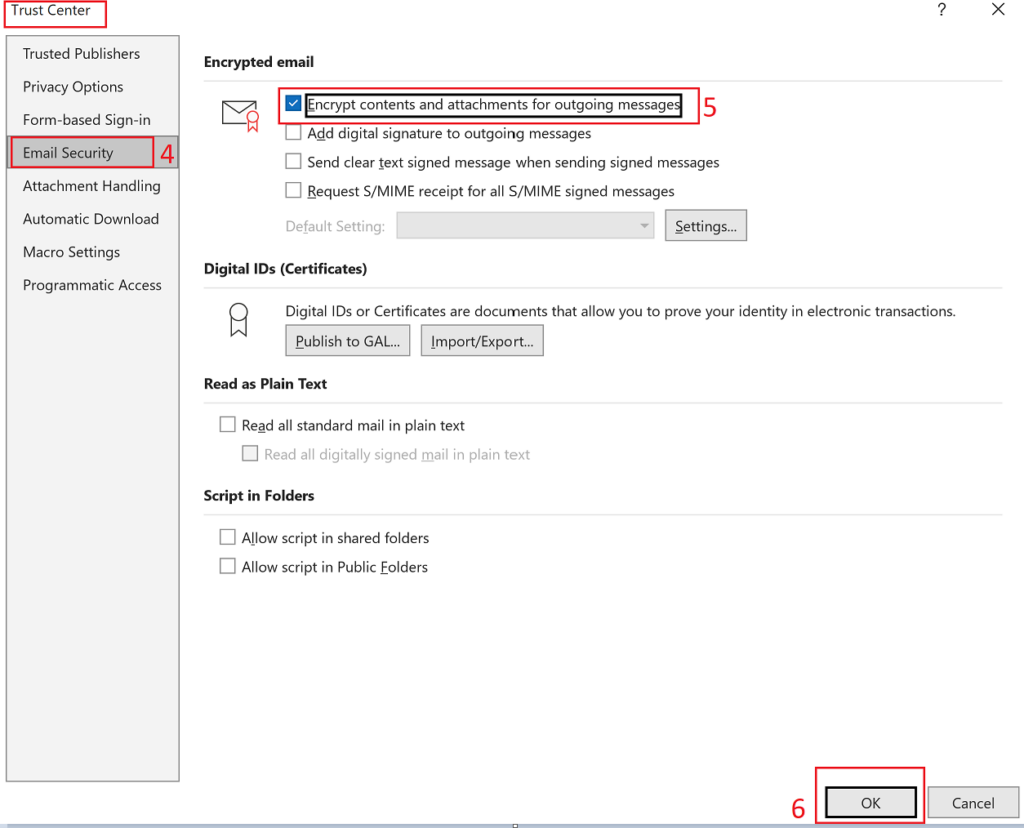
Encrypting Emails Using S/MIME
S/MIME is an email encryption protocol that uses digital certificates to authenticate senders and recipients and to encrypt email messages. S/MIME is used in both Outlook and Gmail.
Here are the steps to encrypt an email using S/MIME:
Step 1: Before you start, you must first have added a certificate to the keychain on your computer. Once you have your signing certificate set up on your computer, you’ll need to configure it in Outlook.
Step 2: Compose a new email message in Outlook.
Step 3: Click on the “Options” tab in the ribbon at the top of the email window.
Step 4: Click on “Encrypt” in the “Permission” section of the ribbon.
Step 5: Click on “S/MIME Settings” to configure S/MIME.
Step 6: In the S/MIME Settings dialog box, select the certificate you want to use for encryption.
Step 7: Click on “OK” to save the changes.
Step 8: Click on “Send” to send the encrypted email.
Encrypting Emails Using Outlook.com
Outlook.com is a free email service provided by Microsoft. It offers a built-in encryption feature that allows users to send encrypted emails. Here are the steps to encrypt an email using Outlook.com:
Step 1: Log in to your Outlook.com account.
Step 2: Click on “New Message” to compose a new email message.
Step 3: Click on the “More options” button (represented by three dots) in the toolbar.
Step 4: Click on “Encrypt” in the drop-down menu.
Step 5: Type your message and click on “Send” to send the encrypted email.
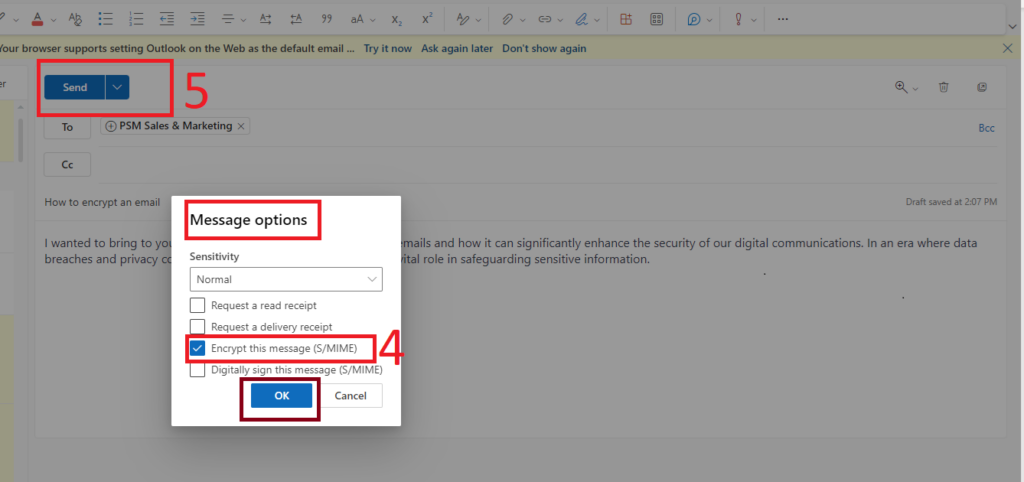
Encrypting Emails Using a Third-Party Add-In
There are several third-party email encryption services that you can use to encrypt your emails in Outlook. Trustifi is an example of an email encryption service that offers various security features, compliance with data protection laws, and seamless integration into email platforms. These add-ins provide additional features and functionality that may not be available in the built-in encryption options. Some popular add-ins include Virtru, ZixMail, and Cryptshare.
To use a third-party encryption add-in, follow these steps:
Step 1: Go to the website of the encryption add-in you want to use.
Step 2: Download and install the add-in.
Step 3: Open Outlook and create a new email message.
Step 4: Click on the add-in button to open the encryption options.
Step 5: Select the encryption options you want and send the encrypted email.
Best Practices for Secure Email Encryption
To ensure maximum security when encrypting emails in Outlook, it’s essential to follow some best practices. These practices include:
Double-Check Email Addresses: Verify the email addresses of the intended recipients to ensure accuracy. Sending an encrypted email to the wrong recipient could potentially compromise the confidentiality of the message. Pay extra attention when using autocomplete or copying and pasting email addresses to avoid any mistakes.
Clearly Communicate Encryption Method: Clearly communicate to the recipient how the email is encrypted and provide any necessary instructions for decryption. This can include specifying the encryption software used, mentioning if any passcodes or keys are required.
Consider Using a Secure Delivery Method: If the content of the email is highly sensitive, consider using a secure file transfer service or a secure messaging platform instead of traditional email. These services often provide stronger encryption and additional security features, further safeguarding the confidentiality of your communication.
Avoid Including Sensitive Information in Subject Lines: Refrain from including sensitive or confidential information in the subject line of an encrypted email. Subject lines are typically not encrypted and can be seen even before the email is opened. Keep the subject line generic or use a neutral description that doesn’t reveal any sensitive details.
Be Mindful of Reply-All and Forwarding: Encrypted emails often contain a “do not forward” or similar restriction. Remind the recipient to exercise caution when replying or forwarding the encrypted email, ensuring they adhere to any restrictions or privacy concerns associated with the message.
Regularly Update Encryption Software: Keep your email client and encryption software up to date with the latest security patches and updates. This helps address any known vulnerabilities and ensures that you are using the most secure versions available.
Use strong passwords:Use strong passwords to protect your email account and encryption key. A strong password should be at least eight characters long and include a combination of upper and lowercase letters, numbers, and special characters.
Educate Users: Provide training and guidelines to educate users on how to send and handle encrypted emails correctly. Ensure they understand the importance of encryption, how to use encryption tools effectively, and any specific policies or procedures related to encrypted communication within your organization.
Gmail’s Confidential mode is another effective way to secure email communication. This mode prevents recipients from forwarding, copying, printing, or downloading emails and their attachments. Additionally, you can set expiration dates and use SMS passcodes for added security. Securing Gmail messages through Confidential mode contributes significantly to maintaining a secure email environment.
By following these best practices, you can ensure that your encrypted emails are sent securely and the sensitive information they contain remains protected throughout the communication process.
IT Consulting Services at PSM Partners
Transform your IT landscape with PSM Partners’ expert cybersecurity and IT consulting services. Based in Chicago, IL, we specialize in IT management and strategy consulting for businesses and institutions. Our dedicated professionals prioritize your unique requirements, ensuring transparency and offering unbiased solutions to bolster your technologies and drive your IT initiatives forward. Leveraging a comprehensive assessment of your current IT system and business objectives, the experts at PSM Partners strive to deliver targeted value where it matters most.
Ready to revolutionize your IT strategy? Contact PSM today at (312) 940-7830 or fill out our convenient contact form to discover how our technology consulting expertise can empower your organization.
Related Insights
Understanding the CDK Cyber Attack: What Happened and What Businesses Can Learn
Key Takeaways From the CDK Global Cyber Attack Massive DisruptionOn...
Read MoreCloud Engineer vs. Software Engineer: Understanding the Differences
In today’s rapidly evolving technology landscape, both cloud and software...
Read MoreCybersecurity Jobs to Hire in 2025: Building a Strong Team for the Future
The cybersecurity job market is evolving rapidly, driven by advancements...
Read MoreWhat Users Can Expect After The NetDocuments, Worldox Acquisition
Efficient document management is the key to the success of...
Read MoreIdentifying Your Cyber Vulnerabilities and Data Breaches
Before beginning the application process for cyber insurance, it is important to identify all cyber vulnerabilities within your company. This step is vital as it enables your insurance provider to tailor coverage that properly safeguards both you and your customers. Additionally, recognizing the level of risk posed by your cyber infrastructure can greatly impact the cost of your policy. By assessing and addressing your cyber risks upfront, you lay a strong foundation for a custom insurance solution that aligns with your cybersecurity needs and financial objectives.

